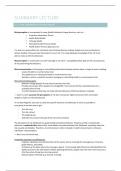Summary
Summary for HEP4211
- Course
- Institution
I made a summary of all the summary lectures + I added information from the mini lectures in case I felt like it was needed. The course has changed from last year so this is the most up to date summary!
[Show more]



